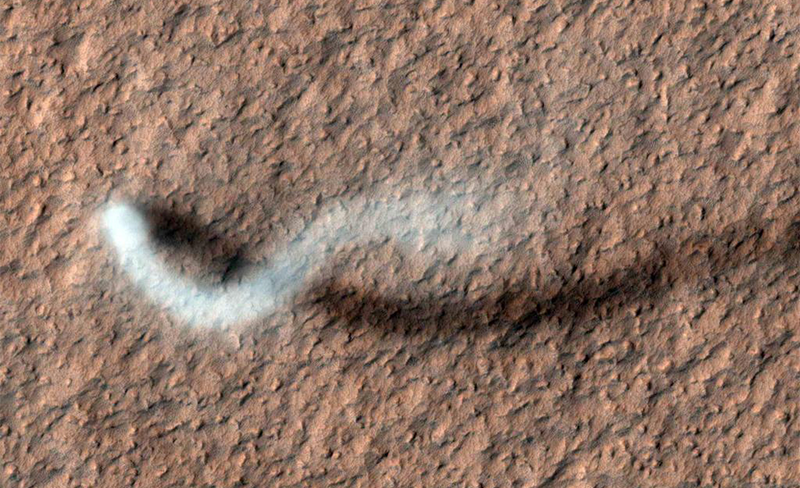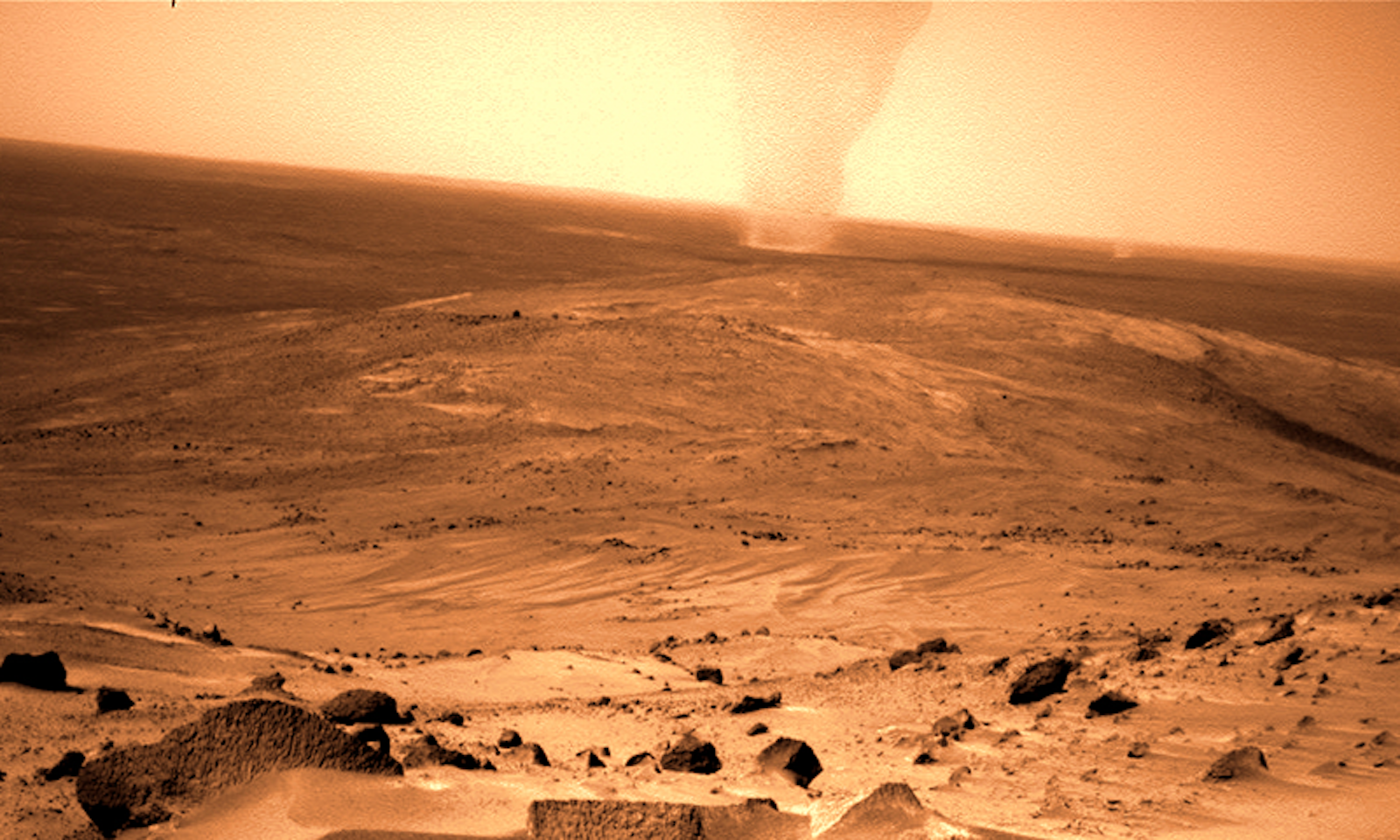When I first heard it, it sounded like a brief, blustery outtake. A momentary lull in an outdoor event captured by an old camcorder. A sonic slice of a windy afternoon anywhere on Earth.
The sound was indeed wind whipping past a microphone. But wind on another planet. Wind on Mars. The recording, released by NASA in December 2022, is the first time humans have ever heard a Mars-made sound.
Scientists have known for years that the surface of the Red Planet is alive with wind, which creates spiraling dust devils—and planet-engulfing megastorms. But until now they’ve had to watch these events unfold in frustrated silence. “It’s like you’ve experienced something with one of your senses for a long time, but you’ve never experienced it with another,” says Roger Wiens, a professor of planetary science at Purdue University. “And now we have that second sense experience.”
Wiens is a coauthor of the recent paper describing NASA’s new earworm1 as well as the lead scientist for the NASA Perseverance rover’s suite of observational tools, known collectively as the SuperCam, designed to gather new information about Mars.
The interesting thing about wind on Mars is that it is actually quite gentle.
To conserve resources, the rover’s microphone is rarely listening—it was on for less than 85 minutes for the entire first year of the mission. But on Sept. 27, 2021, at 11:02 local Mars time, it just happened to be cycling through one of its short listening bursts when a dust devil, some 387 feet tall, swept not just nearby but across the rover itself. And the microphone, located “almost at a human ear level” Wiens points out, picked up not only the two sides of the devil and its quiet eye, but also the sound of its dust.
“It’s one thing to hear a gust of wind, but to know that it’s a part of this pattern of dust devils that we have seen for many years on Mars, that was like a dream come true,” says Wiens.
Sound might seem a rather low-fi channel with which to gather data from our solar system, when our rovers are outfitted with lasers, ground-penetrating radar, and X-ray fluorescence spectrometers. But to Wien’s ears, sound is rich with information that is otherwise elusive.
In the recording, “we actually could hear sand grains pummeling the rover,” Wiens says. “The wind itself tends to make a low pitch, and then the sand grains hitting a higher pitch.” The scientists used those discrete sounds to estimate the density of dust grains in the entire dust devil.
And there is one sound in this recording that he and his colleagues are still straining to decipher. “There’s one sort of loud snap in the middle,” he says. It could either be a grain of sand hitting the microphone directly—or an electrostatic pop, from the charging that happens in these bone-dry dust clouds.

The full weather station on Perseverance was also up and running at the time of the dust devil’s passage, so scientists were able to match the sound recording with temperature, pressure, and wind speed and direction. Writing in Nature Portfolio’s Astronomy Community, Alexander Stott, a coauthor of the paper and a postdoctoral researcher at the University of Toulouse, observed2 that precisely 199 years before this Martian gust was recorded, on the very same day in September, the French linguist Jean-François Champollion reported that he had decoded the Rosetta Stone. “In a similar way, the Perseverance rover employs multiple techniques and measurements to decipher the Martian atmosphere,” Stott wrote.
When we hear wind on Earth, what we are hearing—aside from its impact on objects around us (leaves brushing against one another, for example)—is primarily the jumble of the atmosphere’s rushing molecules themselves as they get knocked off their course by the structure of our ears. (We can shape this sound by turning our heads into or away from—or perpendicular to—the wind, creating different amounts and types of turbulence around our ears.) The same physical dynamics, as it turns out, are at play with a microphone on Mars. “It’s making that turbulent sound as it’s flowing past the corners of the box,” Wiens explains of the detected Martian wind.
The interesting thing about wind on Mars is that, despite the menacing appearance of the dust storms it generates, it is actually quite gentle. With atmospheric pressure just 1 percent of Earth’s, even the planet’s stiffest gust, of 60 miles per hour, packs no punch and would likely feel like little more than a gentle waft to us. (Which offers reassurance that the setup for The Martian—in which a violent windstorm causes such severe damage that it essentially strands a scientist—would never befall any real operations there.)
Sound is exceedingly rare in the universe.
This low density of gas molecules is likely the reason for the frequent dust devils on Mars. Just like on Earth, Martian molecules like to flow from high pressure to low. These pressure disparities arise when there are sizable differences in temperatures. Because the air molecules on Mars are so few and far between, they’re not able to retain heat from the sun as effectively as the more densely packed ones here in our atmosphere. So there is a dramatic temperature gradient above the ground—often spanning 35 degrees Fahrenheit in several feet. “So it could be mildly warm down by your feet, and your eyelashes could have frost on them,” Wiens says. These hyperlocal temperature differences create just the right conditions to kick up swirling dust devils.
Weak and dust-filled as it is, this wind is actually a helpful collaborator. The dust on Mars contains superfine particles, just the type that can coat the solar panels that power much of the surface-based science. So a gust here and there can help clear off these essential components. Which has added unexpected longevity to some of humanity’s missions. In January 2004, NASA rovers Spirit and Opportunity landed on Mars with life expectancies of about 90 days. At the time, we “were not aware that the dust devils would come along and clean those panels off,” Wiens says. But the two rovers plodded along on Mars’ blustery surface until 2010 and 2018, respectively. Not all areas of the planet, though, are as breezy. The InSight lander, which arrived on the flat plain of Elysium Planitia in late 2018, powered down in late December 2022 because accumulated dust ultimately blocked the sunlight.
Earth is a noisy planet. But without life, sounds here would be limited to those of wind and water and the occasional geological event. On Mars the only likely homespun sound to listen for is wind. (Most other sound studies on Mars have been from human-cued noises: plasma laser zaps, rotating helicopter blades.) Learning about sound on other planets can help scientists understand more about how they could use these pressure waves in future research.
But sound is exceedingly rare in the universe. It needs fairly tightly packed particles—like those in an atmosphere—to propagate. “So the moon is no good for that,” Wiens says. Neither is Mercury. Even supernovae are essentially silent. When I ask what he would pick if he could listen to anything in the galaxy, he pauses for a moment to consider places that might have sound.
Finally, he lands on Titan, one of Saturn’s more alluring moons. Which is perhaps no coincidence. NASA is currently building a helicopter, named Dragonfly, that will begin its journey to Titan in just a few years. Dragonfly will be equipped with microphones for careful listening, and perhaps not just for wind. Scientists suspect Titan has super-cold liquid methane on its surface. “So if we’re really lucky, we would hear the sound of liquid, as well as the sound of wind. But who knows,” Wiens muses.
For now, Perseverance will keep listening, a few fleeting moments at a time, on Mars. And any new sounds it picks up will hopefully bring novel insights about atmospheres and physics beyond our own planet, Wiens says. Because driving all of this, he tells me, is not just intel gathering for future basecamps on Mars, but also, “a curiosity about how the physics of the universe works.” ![]()
Katherine Harmon Courage is the deputy editor at Nautilus. Follow her on Twitter @KHCourage.
Lead image: NASA/JPL
References
1. Murdoch, N., et al. The sound of a Martian dust devil. Nature Communications 13, 7505 (2022).
2. Stott, A. Listening to dust devils on Mars. astronomycommunity.nature.com (2022).


























